Environmental Management System Report: SIX Construction Firm Analysis
VerifiedAdded on 2020/03/16
|16
|3682
|50
Report
AI Summary
This report provides a comprehensive overview of the Environmental Management System (EMS) for SIX Construction Company. It begins by defining EMS and its relationship to the ISO 14001 standard, emphasizing the benefits of certification. The report then identifies key stakeholders, including suppliers, financial firms, trade associations, electricians, and clients, outlining their respective needs and interests. A detailed analysis of the construction processes, including preparation, foundation, construction, decoration, and cleaning/inspection, is presented, along with the environmental aspects and impacts associated with each stage. The report further outlines potential environmental objectives and actions that SIX Construction can implement to mitigate negative impacts, such as dust control, waste recycling, and the use of eco-friendly materials. Monitoring and measuring performance through statistical gathering, air quality monitoring, noise monitoring, and worker skill examinations are also discussed. The report concludes by highlighting the merits and demerits of implementing an EMS within the construction firm, providing valuable insights for sustainable practices.

Running head: ENVIRONMENTAL MANAGEMENT SYSTEM 0
MASTER OF ENGINEERING MANAGEMENT
Institution
Tutor
Name
Date
MASTER OF ENGINEERING MANAGEMENT
Institution
Tutor
Name
Date
Paraphrase This Document
Need a fresh take? Get an instant paraphrase of this document with our AI Paraphraser
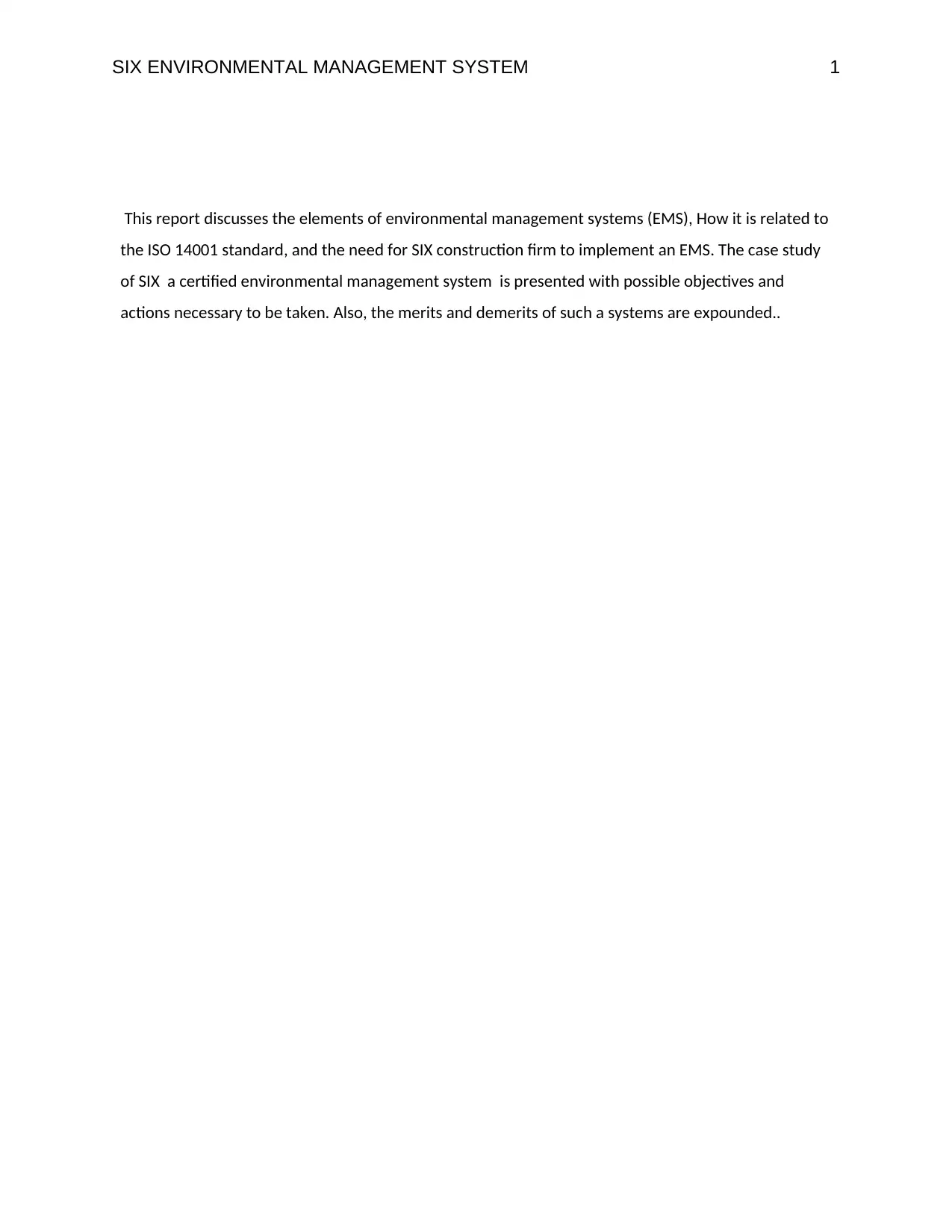
SIX ENVIRONMENTAL MANAGEMENT SYSTEM 1
This report discusses the elements of environmental management systems (EMS), How it is related to
the ISO 14001 standard, and the need for SIX construction firm to implement an EMS. The case study
of SIX a certified environmental management system is presented with possible objectives and
actions necessary to be taken. Also, the merits and demerits of such a systems are expounded..
This report discusses the elements of environmental management systems (EMS), How it is related to
the ISO 14001 standard, and the need for SIX construction firm to implement an EMS. The case study
of SIX a certified environmental management system is presented with possible objectives and
actions necessary to be taken. Also, the merits and demerits of such a systems are expounded..

SIX ENVIRONMENTAL MANAGEMENT SYSTEM 2
Table of Contents
Abbreviations................................................................................................................... 4
2.1 Environmental Management System (EMS):.............................................................5
2.2 The Stakeholders of the Company and their needs...................................................6
2.2.1 Suppliers..............................................................................................................6
2.2.2 Financial Firms.....................................................................................................6
2.2.3 Trade Associations.............................................................................................. 6
2.2,4 Electrician............................................................................................................ 7
2.2.5 Client/ Investors...................................................................................................7
of 2.3 Process and Sub-processes construction..............................................................7
2.3.1 Preparation Process............................................................................................7
2.3.2 Foundation Process.............................................................................................7
2.3.3 Construction Process...........................................................................................8
2.3.4 Decoration process..............................................................................................8
2.3.5 Clean and Inspection Process.............................................................................8
2.4 Environmental Aspects in these Processes...............................................................8
2.4.1 Construction Aspects...........................................................................................8
2.4.2 Decoration Process Aspects................................................................................9
2.5 Environmental Impacts...............................................................................................9
2.5.1 Construction Process Impact...............................................................................9
2.5.2 Decoration Process Impact..................................................................................9
Table of Contents
Abbreviations................................................................................................................... 4
2.1 Environmental Management System (EMS):.............................................................5
2.2 The Stakeholders of the Company and their needs...................................................6
2.2.1 Suppliers..............................................................................................................6
2.2.2 Financial Firms.....................................................................................................6
2.2.3 Trade Associations.............................................................................................. 6
2.2,4 Electrician............................................................................................................ 7
2.2.5 Client/ Investors...................................................................................................7
of 2.3 Process and Sub-processes construction..............................................................7
2.3.1 Preparation Process............................................................................................7
2.3.2 Foundation Process.............................................................................................7
2.3.3 Construction Process...........................................................................................8
2.3.4 Decoration process..............................................................................................8
2.3.5 Clean and Inspection Process.............................................................................8
2.4 Environmental Aspects in these Processes...............................................................8
2.4.1 Construction Aspects...........................................................................................8
2.4.2 Decoration Process Aspects................................................................................9
2.5 Environmental Impacts...............................................................................................9
2.5.1 Construction Process Impact...............................................................................9
2.5.2 Decoration Process Impact..................................................................................9
⊘ This is a preview!⊘
Do you want full access?
Subscribe today to unlock all pages.

Trusted by 1+ million students worldwide
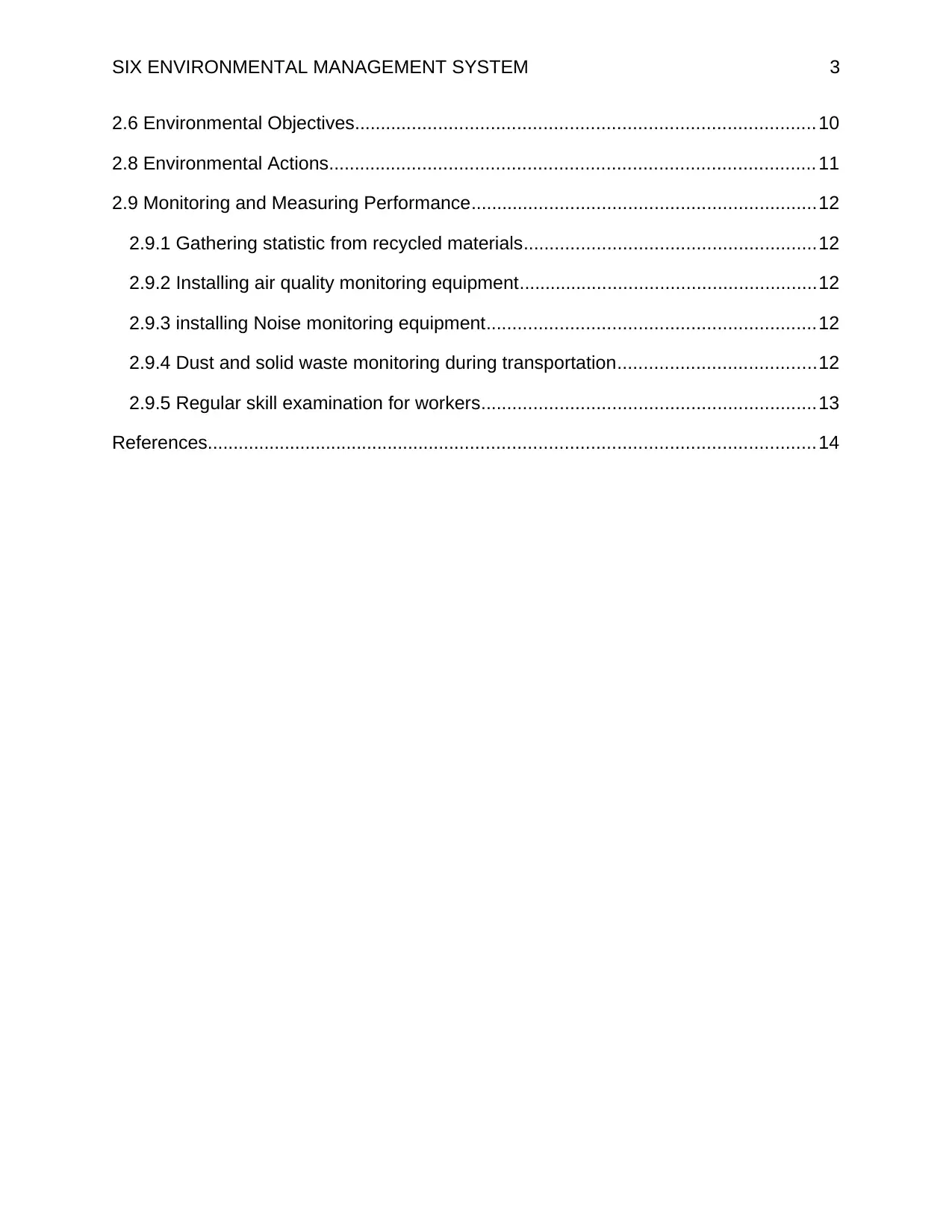
SIX ENVIRONMENTAL MANAGEMENT SYSTEM 3
2.6 Environmental Objectives........................................................................................ 10
2.8 Environmental Actions............................................................................................. 11
2.9 Monitoring and Measuring Performance..................................................................12
2.9.1 Gathering statistic from recycled materials........................................................12
2.9.2 Installing air quality monitoring equipment.........................................................12
2.9.3 installing Noise monitoring equipment...............................................................12
2.9.4 Dust and solid waste monitoring during transportation......................................12
2.9.5 Regular skill examination for workers................................................................13
References.....................................................................................................................14
2.6 Environmental Objectives........................................................................................ 10
2.8 Environmental Actions............................................................................................. 11
2.9 Monitoring and Measuring Performance..................................................................12
2.9.1 Gathering statistic from recycled materials........................................................12
2.9.2 Installing air quality monitoring equipment.........................................................12
2.9.3 installing Noise monitoring equipment...............................................................12
2.9.4 Dust and solid waste monitoring during transportation......................................12
2.9.5 Regular skill examination for workers................................................................13
References.....................................................................................................................14
Paraphrase This Document
Need a fresh take? Get an instant paraphrase of this document with our AI Paraphraser

SIX ENVIRONMENTAL MANAGEMENT SYSTEM 4
Abbreviations
EMS Environmental Management System
ISO International Organization for Standardization
Abbreviations
EMS Environmental Management System
ISO International Organization for Standardization
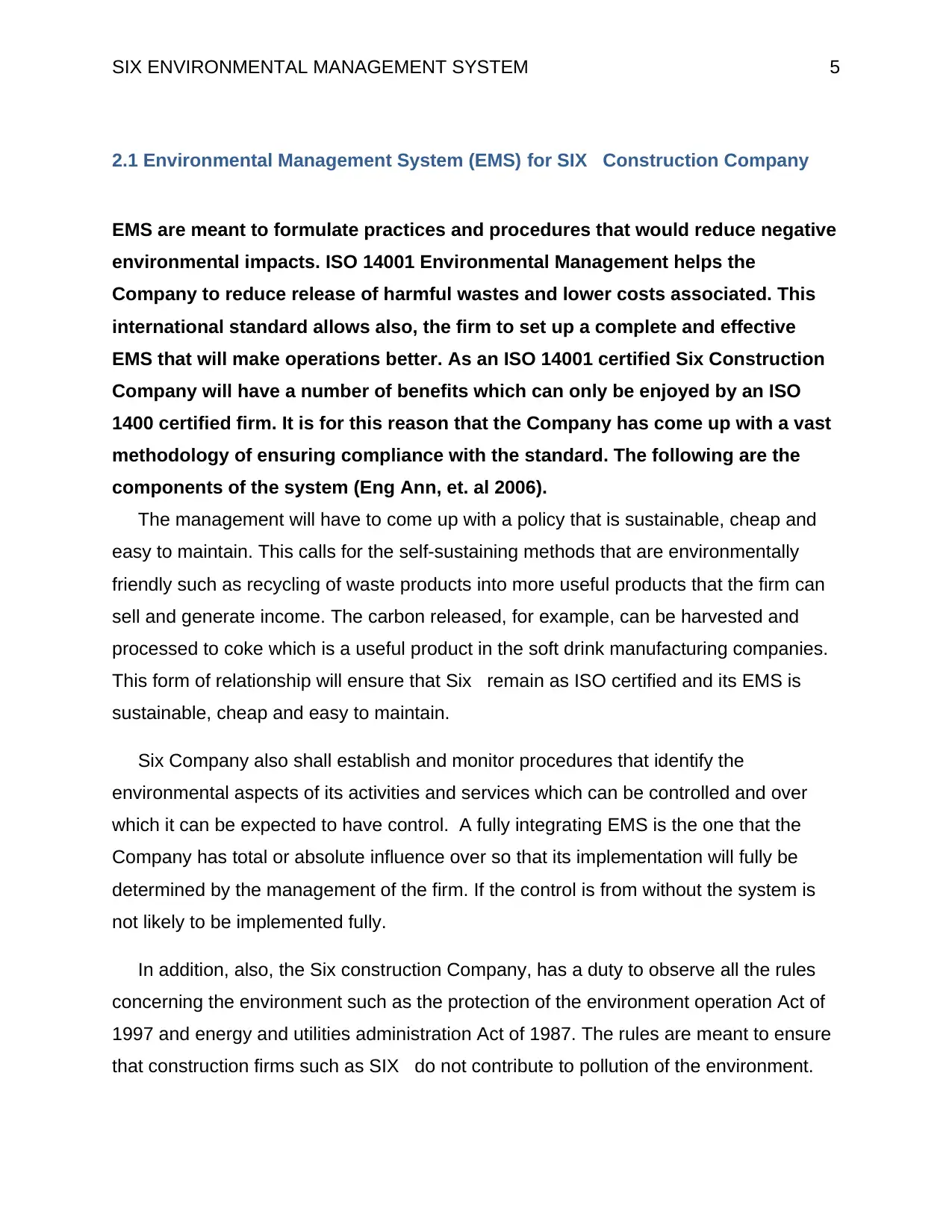
SIX ENVIRONMENTAL MANAGEMENT SYSTEM 5
2.1 Environmental Management System (EMS) for SIX Construction Company
EMS are meant to formulate practices and procedures that would reduce negative
environmental impacts. ISO 14001 Environmental Management helps the
Company to reduce release of harmful wastes and lower costs associated. This
international standard allows also, the firm to set up a complete and effective
EMS that will make operations better. As an ISO 14001 certified Six Construction
Company will have a number of benefits which can only be enjoyed by an ISO
1400 certified firm. It is for this reason that the Company has come up with a vast
methodology of ensuring compliance with the standard. The following are the
components of the system (Eng Ann, et. al 2006).
The management will have to come up with a policy that is sustainable, cheap and
easy to maintain. This calls for the self-sustaining methods that are environmentally
friendly such as recycling of waste products into more useful products that the firm can
sell and generate income. The carbon released, for example, can be harvested and
processed to coke which is a useful product in the soft drink manufacturing companies.
This form of relationship will ensure that Six remain as ISO certified and its EMS is
sustainable, cheap and easy to maintain.
Six Company also shall establish and monitor procedures that identify the
environmental aspects of its activities and services which can be controlled and over
which it can be expected to have control. A fully integrating EMS is the one that the
Company has total or absolute influence over so that its implementation will fully be
determined by the management of the firm. If the control is from without the system is
not likely to be implemented fully.
In addition, also, the Six construction Company, has a duty to observe all the rules
concerning the environment such as the protection of the environment operation Act of
1997 and energy and utilities administration Act of 1987. The rules are meant to ensure
that construction firms such as SIX do not contribute to pollution of the environment.
2.1 Environmental Management System (EMS) for SIX Construction Company
EMS are meant to formulate practices and procedures that would reduce negative
environmental impacts. ISO 14001 Environmental Management helps the
Company to reduce release of harmful wastes and lower costs associated. This
international standard allows also, the firm to set up a complete and effective
EMS that will make operations better. As an ISO 14001 certified Six Construction
Company will have a number of benefits which can only be enjoyed by an ISO
1400 certified firm. It is for this reason that the Company has come up with a vast
methodology of ensuring compliance with the standard. The following are the
components of the system (Eng Ann, et. al 2006).
The management will have to come up with a policy that is sustainable, cheap and
easy to maintain. This calls for the self-sustaining methods that are environmentally
friendly such as recycling of waste products into more useful products that the firm can
sell and generate income. The carbon released, for example, can be harvested and
processed to coke which is a useful product in the soft drink manufacturing companies.
This form of relationship will ensure that Six remain as ISO certified and its EMS is
sustainable, cheap and easy to maintain.
Six Company also shall establish and monitor procedures that identify the
environmental aspects of its activities and services which can be controlled and over
which it can be expected to have control. A fully integrating EMS is the one that the
Company has total or absolute influence over so that its implementation will fully be
determined by the management of the firm. If the control is from without the system is
not likely to be implemented fully.
In addition, also, the Six construction Company, has a duty to observe all the rules
concerning the environment such as the protection of the environment operation Act of
1997 and energy and utilities administration Act of 1987. The rules are meant to ensure
that construction firms such as SIX do not contribute to pollution of the environment.
⊘ This is a preview!⊘
Do you want full access?
Subscribe today to unlock all pages.

Trusted by 1+ million students worldwide
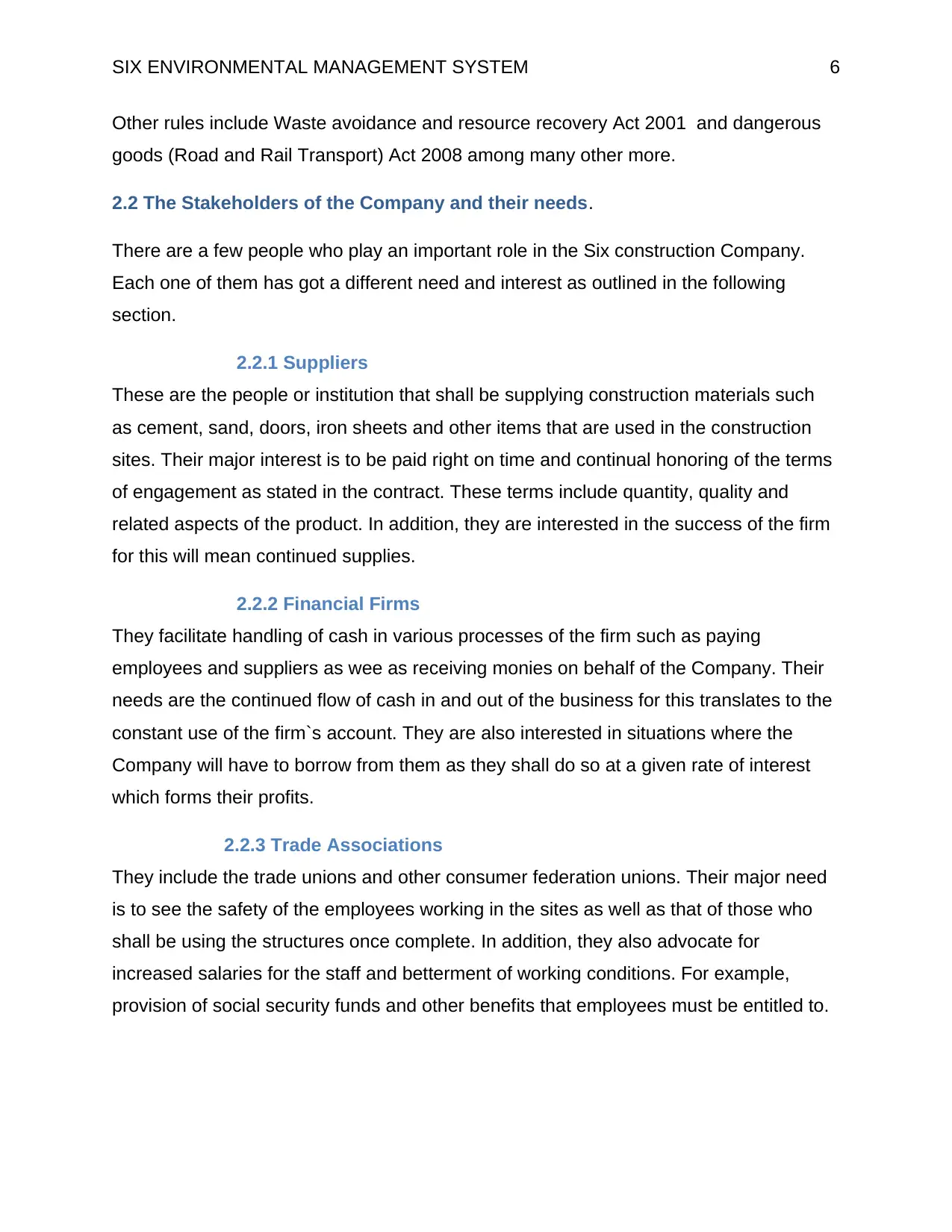
SIX ENVIRONMENTAL MANAGEMENT SYSTEM 6
Other rules include Waste avoidance and resource recovery Act 2001 and dangerous
goods (Road and Rail Transport) Act 2008 among many other more.
2.2 The Stakeholders of the Company and their needs.
There are a few people who play an important role in the Six construction Company.
Each one of them has got a different need and interest as outlined in the following
section.
2.2.1 Suppliers
These are the people or institution that shall be supplying construction materials such
as cement, sand, doors, iron sheets and other items that are used in the construction
sites. Their major interest is to be paid right on time and continual honoring of the terms
of engagement as stated in the contract. These terms include quantity, quality and
related aspects of the product. In addition, they are interested in the success of the firm
for this will mean continued supplies.
2.2.2 Financial Firms
They facilitate handling of cash in various processes of the firm such as paying
employees and suppliers as wee as receiving monies on behalf of the Company. Their
needs are the continued flow of cash in and out of the business for this translates to the
constant use of the firm`s account. They are also interested in situations where the
Company will have to borrow from them as they shall do so at a given rate of interest
which forms their profits.
2.2.3 Trade Associations
They include the trade unions and other consumer federation unions. Their major need
is to see the safety of the employees working in the sites as well as that of those who
shall be using the structures once complete. In addition, they also advocate for
increased salaries for the staff and betterment of working conditions. For example,
provision of social security funds and other benefits that employees must be entitled to.
Other rules include Waste avoidance and resource recovery Act 2001 and dangerous
goods (Road and Rail Transport) Act 2008 among many other more.
2.2 The Stakeholders of the Company and their needs.
There are a few people who play an important role in the Six construction Company.
Each one of them has got a different need and interest as outlined in the following
section.
2.2.1 Suppliers
These are the people or institution that shall be supplying construction materials such
as cement, sand, doors, iron sheets and other items that are used in the construction
sites. Their major interest is to be paid right on time and continual honoring of the terms
of engagement as stated in the contract. These terms include quantity, quality and
related aspects of the product. In addition, they are interested in the success of the firm
for this will mean continued supplies.
2.2.2 Financial Firms
They facilitate handling of cash in various processes of the firm such as paying
employees and suppliers as wee as receiving monies on behalf of the Company. Their
needs are the continued flow of cash in and out of the business for this translates to the
constant use of the firm`s account. They are also interested in situations where the
Company will have to borrow from them as they shall do so at a given rate of interest
which forms their profits.
2.2.3 Trade Associations
They include the trade unions and other consumer federation unions. Their major need
is to see the safety of the employees working in the sites as well as that of those who
shall be using the structures once complete. In addition, they also advocate for
increased salaries for the staff and betterment of working conditions. For example,
provision of social security funds and other benefits that employees must be entitled to.
Paraphrase This Document
Need a fresh take? Get an instant paraphrase of this document with our AI Paraphraser
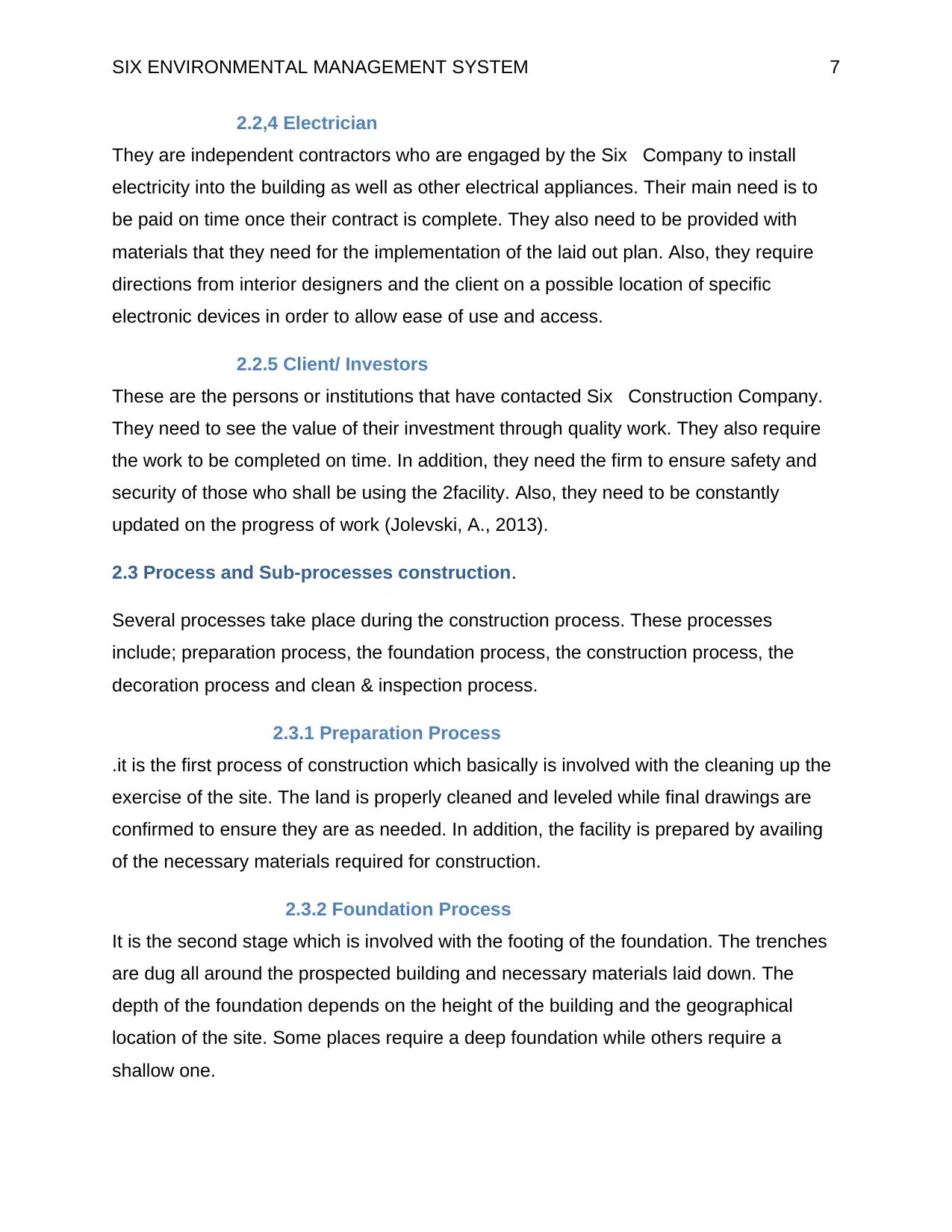
SIX ENVIRONMENTAL MANAGEMENT SYSTEM 7
2.2,4 Electrician
They are independent contractors who are engaged by the Six Company to install
electricity into the building as well as other electrical appliances. Their main need is to
be paid on time once their contract is complete. They also need to be provided with
materials that they need for the implementation of the laid out plan. Also, they require
directions from interior designers and the client on a possible location of specific
electronic devices in order to allow ease of use and access.
2.2.5 Client/ Investors
These are the persons or institutions that have contacted Six Construction Company.
They need to see the value of their investment through quality work. They also require
the work to be completed on time. In addition, they need the firm to ensure safety and
security of those who shall be using the 2facility. Also, they need to be constantly
updated on the progress of work (Jolevski, A., 2013).
2.3 Process and Sub-processes construction.
Several processes take place during the construction process. These processes
include; preparation process, the foundation process, the construction process, the
decoration process and clean & inspection process.
2.3.1 Preparation Process
.it is the first process of construction which basically is involved with the cleaning up the
exercise of the site. The land is properly cleaned and leveled while final drawings are
confirmed to ensure they are as needed. In addition, the facility is prepared by availing
of the necessary materials required for construction.
2.3.2 Foundation Process
It is the second stage which is involved with the footing of the foundation. The trenches
are dug all around the prospected building and necessary materials laid down. The
depth of the foundation depends on the height of the building and the geographical
location of the site. Some places require a deep foundation while others require a
shallow one.
2.2,4 Electrician
They are independent contractors who are engaged by the Six Company to install
electricity into the building as well as other electrical appliances. Their main need is to
be paid on time once their contract is complete. They also need to be provided with
materials that they need for the implementation of the laid out plan. Also, they require
directions from interior designers and the client on a possible location of specific
electronic devices in order to allow ease of use and access.
2.2.5 Client/ Investors
These are the persons or institutions that have contacted Six Construction Company.
They need to see the value of their investment through quality work. They also require
the work to be completed on time. In addition, they need the firm to ensure safety and
security of those who shall be using the 2facility. Also, they need to be constantly
updated on the progress of work (Jolevski, A., 2013).
2.3 Process and Sub-processes construction.
Several processes take place during the construction process. These processes
include; preparation process, the foundation process, the construction process, the
decoration process and clean & inspection process.
2.3.1 Preparation Process
.it is the first process of construction which basically is involved with the cleaning up the
exercise of the site. The land is properly cleaned and leveled while final drawings are
confirmed to ensure they are as needed. In addition, the facility is prepared by availing
of the necessary materials required for construction.
2.3.2 Foundation Process
It is the second stage which is involved with the footing of the foundation. The trenches
are dug all around the prospected building and necessary materials laid down. The
depth of the foundation depends on the height of the building and the geographical
location of the site. Some places require a deep foundation while others require a
shallow one.
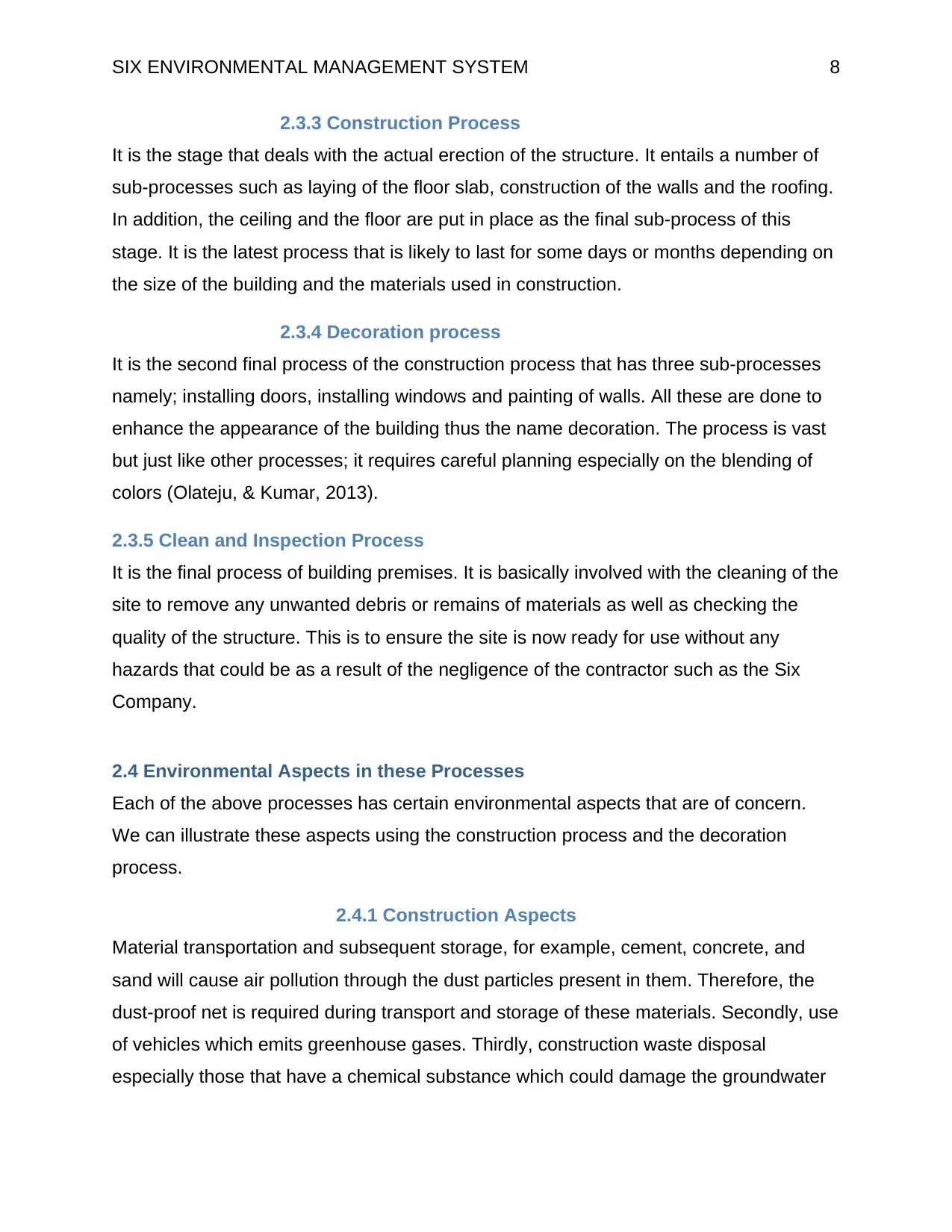
SIX ENVIRONMENTAL MANAGEMENT SYSTEM 8
2.3.3 Construction Process
It is the stage that deals with the actual erection of the structure. It entails a number of
sub-processes such as laying of the floor slab, construction of the walls and the roofing.
In addition, the ceiling and the floor are put in place as the final sub-process of this
stage. It is the latest process that is likely to last for some days or months depending on
the size of the building and the materials used in construction.
2.3.4 Decoration process
It is the second final process of the construction process that has three sub-processes
namely; installing doors, installing windows and painting of walls. All these are done to
enhance the appearance of the building thus the name decoration. The process is vast
but just like other processes; it requires careful planning especially on the blending of
colors (Olateju, & Kumar, 2013).
2.3.5 Clean and Inspection Process
It is the final process of building premises. It is basically involved with the cleaning of the
site to remove any unwanted debris or remains of materials as well as checking the
quality of the structure. This is to ensure the site is now ready for use without any
hazards that could be as a result of the negligence of the contractor such as the Six
Company.
2.4 Environmental Aspects in these Processes
Each of the above processes has certain environmental aspects that are of concern.
We can illustrate these aspects using the construction process and the decoration
process.
2.4.1 Construction Aspects
Material transportation and subsequent storage, for example, cement, concrete, and
sand will cause air pollution through the dust particles present in them. Therefore, the
dust-proof net is required during transport and storage of these materials. Secondly, use
of vehicles which emits greenhouse gases. Thirdly, construction waste disposal
especially those that have a chemical substance which could damage the groundwater
2.3.3 Construction Process
It is the stage that deals with the actual erection of the structure. It entails a number of
sub-processes such as laying of the floor slab, construction of the walls and the roofing.
In addition, the ceiling and the floor are put in place as the final sub-process of this
stage. It is the latest process that is likely to last for some days or months depending on
the size of the building and the materials used in construction.
2.3.4 Decoration process
It is the second final process of the construction process that has three sub-processes
namely; installing doors, installing windows and painting of walls. All these are done to
enhance the appearance of the building thus the name decoration. The process is vast
but just like other processes; it requires careful planning especially on the blending of
colors (Olateju, & Kumar, 2013).
2.3.5 Clean and Inspection Process
It is the final process of building premises. It is basically involved with the cleaning of the
site to remove any unwanted debris or remains of materials as well as checking the
quality of the structure. This is to ensure the site is now ready for use without any
hazards that could be as a result of the negligence of the contractor such as the Six
Company.
2.4 Environmental Aspects in these Processes
Each of the above processes has certain environmental aspects that are of concern.
We can illustrate these aspects using the construction process and the decoration
process.
2.4.1 Construction Aspects
Material transportation and subsequent storage, for example, cement, concrete, and
sand will cause air pollution through the dust particles present in them. Therefore, the
dust-proof net is required during transport and storage of these materials. Secondly, use
of vehicles which emits greenhouse gases. Thirdly, construction waste disposal
especially those that have a chemical substance which could damage the groundwater
⊘ This is a preview!⊘
Do you want full access?
Subscribe today to unlock all pages.

Trusted by 1+ million students worldwide

SIX ENVIRONMENTAL MANAGEMENT SYSTEM 9
and water table. Finally, the noise from construction and building machinery causes
noise pollution which is harmful (Lee et al 2014).
2.4.2 Decoration Process Aspects
The process has some environmental aspects which are of great concern. They include
painting which uses a volatile substance that pollutes the air. Secondly, roof work
entails the use of waterproof material usually bitumen, which is a substance that could
cause air pollution. In fitting operation, the heavy trucks and other vehicles generate
noise and affect the surrounding environment. In addition, windows and doors are a
source of wood and glass cuttings usually caused by poor cutting and wrong
measurement thus increasing solid waste.
2.5 Environmental Impacts
The processes have got several negative impacts on the environment. For the purpose
of this report, I shall expound more on the construction and the decoration processes to
prove these effects.
2.5.1 Construction Process Impact
Dust pollution is mostly the major environmental impact. It normally occurs during the
transportation of materials and their storage, especially cement. There is also air
pollution caused by vehicles coming on the site as well as the fuel consuming
machinery that is on one way or another used in the construction process. In addition,
there is a lot of noise caused by the machines and vehicles coming on the site. Finally,
there is consumption of fuel by both the machines and the vehicles and these are not
environmentally friendly.
2.5.2 Decoration Process Impact
Although the process appears as if it has little or no environmental impact, the fact is a
number of negative effects can be linked to it. These include the use of paints which are
normally toxic when released into the environment. It may kill organic matter and other
creatures in the flora and fauna (Melnyk, et al., 2003). Loading the windows and the
doors caused a lot of noise and the subsequent roofing. Also, the bitumen used in the
roofing cause air pollution while the possibility of leaving broken glass is high.
and water table. Finally, the noise from construction and building machinery causes
noise pollution which is harmful (Lee et al 2014).
2.4.2 Decoration Process Aspects
The process has some environmental aspects which are of great concern. They include
painting which uses a volatile substance that pollutes the air. Secondly, roof work
entails the use of waterproof material usually bitumen, which is a substance that could
cause air pollution. In fitting operation, the heavy trucks and other vehicles generate
noise and affect the surrounding environment. In addition, windows and doors are a
source of wood and glass cuttings usually caused by poor cutting and wrong
measurement thus increasing solid waste.
2.5 Environmental Impacts
The processes have got several negative impacts on the environment. For the purpose
of this report, I shall expound more on the construction and the decoration processes to
prove these effects.
2.5.1 Construction Process Impact
Dust pollution is mostly the major environmental impact. It normally occurs during the
transportation of materials and their storage, especially cement. There is also air
pollution caused by vehicles coming on the site as well as the fuel consuming
machinery that is on one way or another used in the construction process. In addition,
there is a lot of noise caused by the machines and vehicles coming on the site. Finally,
there is consumption of fuel by both the machines and the vehicles and these are not
environmentally friendly.
2.5.2 Decoration Process Impact
Although the process appears as if it has little or no environmental impact, the fact is a
number of negative effects can be linked to it. These include the use of paints which are
normally toxic when released into the environment. It may kill organic matter and other
creatures in the flora and fauna (Melnyk, et al., 2003). Loading the windows and the
doors caused a lot of noise and the subsequent roofing. Also, the bitumen used in the
roofing cause air pollution while the possibility of leaving broken glass is high.
Paraphrase This Document
Need a fresh take? Get an instant paraphrase of this document with our AI Paraphraser

SIX ENVIRONMENTAL MANAGEMENT SYSTEM 10
2.6 Environmental Objectives
Several environmental objectives can be instituted by Six Construction Company to
ensure appropriate use of the natural resources. These objectives include; in material
transportation and storage we can cover them with a dust-proof net to avoid them
causing air pollution. In using the motor vehicles, we can minimize their number and this
will lower fuel consumption. Also, we can decide to use environmentally friendly
vehicles such as the ones powered by solar energy (Eng Ann, et. al 2006). In deciding
on the waste disposal aspect, a good objective should be coming up with ways of
recycling them or re-using them.
In addition, building machinery should have their efficiency increased to lower the
noise and unnecessary emission of gases. Noise can be reduced also by avoiding
making it at night. While painting use environmental friendly oil paint especially the one
that has less odor. The waste from the exercise should also be properly disposed off.
Efficiently using bitumen is also important in lowering pollution Shah, et. al, 2010). While
making the windows and the doors, ensure efficiency and accuracy in measuring to
avoid leaving behind wastes which are actually environmentally harmful. In handling
solid wastes, ensure the industrial solid wastes is translated into a specific area where
they can cause little or no hazards.
. 2.7 Environmental Targets
In the entire objective stated above, have got specific targets that they aim at. This is
well explained below. The issue of covering the materials with the dust-proof net aims at
reducing 95% of dust emissions during transportation. Minimizing the number of
vehicles targets to reduce fully loaded vehicles as possible while the use of
environmentally friendly vehicles aims at reducing 25% of the emissions. The target of
the use recycled material as much as possible is to ensure there are minimal wastes
being released into the environment. The aim of increasing the efficiency of the building
machinery up to 20% ensures noise pollution is minimized (Boiral, 2007). The noise can
also be reduced up to 20% by using soundproof methods.
2.6 Environmental Objectives
Several environmental objectives can be instituted by Six Construction Company to
ensure appropriate use of the natural resources. These objectives include; in material
transportation and storage we can cover them with a dust-proof net to avoid them
causing air pollution. In using the motor vehicles, we can minimize their number and this
will lower fuel consumption. Also, we can decide to use environmentally friendly
vehicles such as the ones powered by solar energy (Eng Ann, et. al 2006). In deciding
on the waste disposal aspect, a good objective should be coming up with ways of
recycling them or re-using them.
In addition, building machinery should have their efficiency increased to lower the
noise and unnecessary emission of gases. Noise can be reduced also by avoiding
making it at night. While painting use environmental friendly oil paint especially the one
that has less odor. The waste from the exercise should also be properly disposed off.
Efficiently using bitumen is also important in lowering pollution Shah, et. al, 2010). While
making the windows and the doors, ensure efficiency and accuracy in measuring to
avoid leaving behind wastes which are actually environmentally harmful. In handling
solid wastes, ensure the industrial solid wastes is translated into a specific area where
they can cause little or no hazards.
. 2.7 Environmental Targets
In the entire objective stated above, have got specific targets that they aim at. This is
well explained below. The issue of covering the materials with the dust-proof net aims at
reducing 95% of dust emissions during transportation. Minimizing the number of
vehicles targets to reduce fully loaded vehicles as possible while the use of
environmentally friendly vehicles aims at reducing 25% of the emissions. The target of
the use recycled material as much as possible is to ensure there are minimal wastes
being released into the environment. The aim of increasing the efficiency of the building
machinery up to 20% ensures noise pollution is minimized (Boiral, 2007). The noise can
also be reduced up to 20% by using soundproof methods.

SIX ENVIRONMENTAL MANAGEMENT SYSTEM 11
In using environmentally friendly paints, we aim at completely changing the oil paint to
better quality that has little or no harm. Carefully disposing of all the painting wastes is
the target of disposal of waste products efficiently. A target of zero waste of bitumen is
the aim of efficiently using bitumen. Also, the target of zero waste of woods and glasses
is as a result of the need to ensure efficient and accurate loading of door and windows.
Finally, the objective of ensuring the waste products are translated into specific areas is
to ensure zero waste of solid waste littered thus a friendly environment.
2.8 Environmental Actions
In achieving all the above-mentioned targets, some activities need to be undertaken.
These activities are well explained below. Firstly, in targeting to reduce 95% of gas
emissions, we need to cover the materials with dust the-proof net, slow down the
vehicles during translation to prevent dust emission and use large tracks instead of
many small vehicles. Secondly, in targeting fully loaded vehicles, we need to reasonably
arrange the transportation and prevent the use of vehicles that exhaust gas emission
below the stipulated limits. Use of environmental friendly vehicles also is an activity that
is aimed at reducing the gas emission. The target of using recycled materials as much
as possible involve two activities namely, the setting of standards for wastes that can be
used in building and arranging a staff who is expected to inspect the recycled material,
make sure it is within limits.
The target of increasing efficiency will involve undertaking two activities, training of the
staffs and shifting works to place them where they are more adaptable. Setting up noise
barriers and using low-noise equipment can be the activities necessary for reducing
20% of the noise. In addition, preventing work at night as well as implementing no noise
work at night are the examples of activities that are aimed at no noise at night. The
target of chafing the paint to environmentally friendly ones can be achieved by using
environmental friendly oil paint and stopping the use of harmful paints.The separation of
garbage disposal and avoiding direct discharge of wastes is an example of methods of
carefully disposing of the paint wastes. The target of zero waste of bitumen is achieved
by using an alternative material instead of bitumen or increasing the efficiency of its use.
In using environmentally friendly paints, we aim at completely changing the oil paint to
better quality that has little or no harm. Carefully disposing of all the painting wastes is
the target of disposal of waste products efficiently. A target of zero waste of bitumen is
the aim of efficiently using bitumen. Also, the target of zero waste of woods and glasses
is as a result of the need to ensure efficient and accurate loading of door and windows.
Finally, the objective of ensuring the waste products are translated into specific areas is
to ensure zero waste of solid waste littered thus a friendly environment.
2.8 Environmental Actions
In achieving all the above-mentioned targets, some activities need to be undertaken.
These activities are well explained below. Firstly, in targeting to reduce 95% of gas
emissions, we need to cover the materials with dust the-proof net, slow down the
vehicles during translation to prevent dust emission and use large tracks instead of
many small vehicles. Secondly, in targeting fully loaded vehicles, we need to reasonably
arrange the transportation and prevent the use of vehicles that exhaust gas emission
below the stipulated limits. Use of environmental friendly vehicles also is an activity that
is aimed at reducing the gas emission. The target of using recycled materials as much
as possible involve two activities namely, the setting of standards for wastes that can be
used in building and arranging a staff who is expected to inspect the recycled material,
make sure it is within limits.
The target of increasing efficiency will involve undertaking two activities, training of the
staffs and shifting works to place them where they are more adaptable. Setting up noise
barriers and using low-noise equipment can be the activities necessary for reducing
20% of the noise. In addition, preventing work at night as well as implementing no noise
work at night are the examples of activities that are aimed at no noise at night. The
target of chafing the paint to environmentally friendly ones can be achieved by using
environmental friendly oil paint and stopping the use of harmful paints.The separation of
garbage disposal and avoiding direct discharge of wastes is an example of methods of
carefully disposing of the paint wastes. The target of zero waste of bitumen is achieved
by using an alternative material instead of bitumen or increasing the efficiency of its use.
⊘ This is a preview!⊘
Do you want full access?
Subscribe today to unlock all pages.

Trusted by 1+ million students worldwide
1 out of 16
Related Documents
Your All-in-One AI-Powered Toolkit for Academic Success.
+13062052269
info@desklib.com
Available 24*7 on WhatsApp / Email
![[object Object]](/_next/static/media/star-bottom.7253800d.svg)
Unlock your academic potential
Copyright © 2020–2025 A2Z Services. All Rights Reserved. Developed and managed by ZUCOL.




